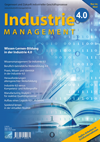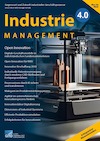Search


Bibtex
Cite as text
@Article{Kump,
Year= "2019",
Number= "2",
Volume= "35",
Pages= "18-22",
Journal = "Industrie 4.0 Management",
Title= "Der Wandel von Praxis, Wissen und Identität in der Industrie 4.0: Automatisierung und Digitalisierung verändern nicht nur „was wir tun“ und „was wir können (müssen)“, sondern auch „wer wir sind“",
Author= "Barbara {Kump}",
Doi= "https://doi.org/10.30844/I40M_19-2_S18-22",
Abstract= "Oft wird bei der Digitalisierung und Automatisierung von Arbeitsprozessen übersehen, dass dadurch für die Organisation gravierende Veränderungen angestoßen werden. Dieser Beitrag zeigt auf, dass solche Veränderungen zu einer Inkongruenz zwischen dem „was eine Organisation tut“ (Praxis), „was sie kann“ (Wissen) und „wer sie ist“ (Identität) führen können. Um Veränderungen erfolgreich umzusetzen, müssen diese Inkongruenzen überwunden werden. Wenn Manager sich dessen bewusst sind, können viele Probleme wie z. B. der Zusammenbruch bestehender Routinen, Wissenslücken oder der Abgang von wichtigen Mitarbeitern vorhergesehen und gelöst werden.",
Keywords= "Organisationale Veränderungen, Automatisierung, Digitalisierung, Change Management",
}
Barbara {Kump}(2019): Der Wandel von Praxis, Wissen und Identität in der Industrie 4.0: Automatisierung und Digitalisierung verändern nicht nur „was wir tun“ und „was wir können (müssen)“, sondern auch „wer wir sind“. 352(2019), S. 18-22. Online: https://doi.org/10.30844/I40M_19-2_S18-22 (Abgerufen 26.07.24)
Open Access
Abstract
Abstract
Oft wird bei der Digitalisierung und Automatisierung von Arbeitsprozessen übersehen, dass dadurch für die Organisation gravierende Veränderungen angestoßen werden. Dieser Beitrag zeigt auf, dass solche Veränderungen zu einer Inkongruenz zwischen dem „was eine Organisation tut“ (Praxis), „was sie kann“ (Wissen) und „wer sie ist“ (Identität) führen können. Um Veränderungen erfolgreich umzusetzen, müssen diese Inkongruenzen überwunden werden. Wenn Manager sich dessen bewusst sind, können viele Probleme wie z. B. der Zusammenbruch bestehender Routinen, Wissenslücken oder der Abgang von wichtigen Mitarbeitern vorhergesehen und gelöst werden.
Keywords
Schlüsselwörter
Organisationale Veränderungen, Automatisierung, Digitalisierung, Change Management
References
Referenzen
[1] Kump, B.: Beyond power struggles: A multi-level perspective on Incongruences at the interface of practice, knowledge, and identity in radical organizational change. The Journal of Applied Behavioral Science (2019), 5-26.
[2] Becker, M. C.: Organizational routines: a review of the literature. Industrial and Corporate Change, 13 (2004) 4, S. 643–678.
[3] Ouellette, J. A.; Wood, W.: Habit and intention in everyday life: The multiple processes by which past behavior predicts future behavior. Psychological Bulletin, 124 (1998) 1, S. 54–74.
[4] Cohen, M. D.; Bacdayan, P.: Organizational routines are stored as procedural memory: Evidence from a laboratory study. Organization Science, 5 (1994) 4, S. 554–568.
[5] Cohen, M. D.; Levinthal, D. A.; Warglien, M.: Collective performance: modeling the interaction of habit-based actions. Industrial and Corporate Change, 23 (2014) 2, S. 329–360.
[6] Hecker, A.: Knowledge beyond the individual? Making sense of a notion of collective knowledge in organization theory. Organization Studies, 33 (2012) 3, S. 423–445.
[7] Kump, B.; Moskaliuk, J.; Cress, U.; Kimmerle, J.. Cognitive foundations of organizational learning: Re-introducing the distinction between declarative and non-declarative knowledge. Frontiers in Psychology, 6 (2015), 1489. URL: http://doi.org/10.3389/fpsyg.2015.01489.
[8] Gioia, D. A.; Patvardhan, S. D.; Hamilton, A. L.; Corley, K. G.: Organizational identity formation and change. The Academy of Management Annals, 7 (2013) 1, S. 123–192.
[9] Albert, S.; Whetten, D. A.: Organizational identity. In: L. L. Cummings & B. M. Staw (Eds.), Research in organizational behavior. Greenwich 1985.
[10] Ashforth, B. E.; Rogers, K. M.; Corley, K. G.: Identity in organizations: Exploring cross-level dynamics. Organization Science, 22 (2011) 5, S. 1144–1156.
[11] Ashforth, B. E.; Harrison, S. H.; Corley, K. G.: Identification in organizations: An examination of four fundamental questions. Journal of Management, 34 (2008) 3, S. 325–374.
[12] Edwards, M. R.: Organizational identification: A conceptual and operational review. International Journal of Management Reviews, 7 (2005) 4, S. 207–230.
[13] Riketta, M.: Organizational identification: A meta-analysis. Journal of Vocational Behavior, 66 (2005) 2, S. 358–384.
[14] Haslam, S. A.; Postmes, T.; Ellemers, N.: More than a metaphor: Organizational identity makes organizational life possible. British Journal of Management, 14 (2003) 4, S. 357–369.
[15] qNicolini, D.: Practice as the site of knowing: Insights from the field of telemedicine. Organization Science, 22 (2011) 3, S. 602–620.
[16] Fiol, C. M.; Lyles, M. A.: Organizational learning. The Academy of Management Review, 10 (1985) 4, S. 803–813.
[17] Ashcraft, K. L.: The glass slipper: “Incorporating” occupational identity in management studies. Academy of Management Review, 38 (2013) 1, S. 6–31.
[18] Nag, R.; Corley, K. G.; Gioia, D. A.: The intersection of organizational identity, knowledge, and practice: Attempting strategic change via knowledge grafting. Academy of Management Journal, 50 (2007) 4, S. 821–847.
[19] Bartunek, J. M.; Rousseau, D. M.; Rudolph, J. W.; DePalma, J. A.: On the receiving end: Sensemaking, emotion, and assessments of an organizational change initiated by others. The Journal of Applied Behavioral Science, 42 (2006) 2, S. 182–206.
[20] Fedor, D. B.; Caldwell, S.; Herold, D. M.: The effects of organizational changes on employee commitment: A multilevel investigation. Personnel Psychology, 59 (2006) 1, S. 1–29.
[21] Oreg, S.; Vakola, M.; Armenakis, A.: Change Recipients’ Reactions to Organizational Change: A 60-Year Review of Quantitative Studies. The Journal of Applied Behavioral Science, 47 (2011) 4, S. 461–524.
[22] Hargadon, A.; Fanelli, A.: Action and possibility. Organization Science, 13 (2002) 3, S. 290–302.
[23] Smith, W. K.; Lewis, M. W.: Toward a theory of paradox: A dynamic equilibrium model of organizing. Academy of Management Review, 36 (2011) 2, S. 381–403.
[24] Nelson, A. J.; Irwin, J.: “Defining what we do – All over again”: Occupational identity, technological change, and the librarian/internet-search relationship. Academy of Management Journal, 57 (2014) 3, S. 892–928.
[25] Hislop, D.; Bosley, S.; Coombs, C. R.; Holland, J.: The process of individual unlearning: A neglected topic in an under-researched field. Management Learning, 45 (2014) 5, S. 540–560.
[26] Cohen, M. D.: Reading Dewey: Reflections on the study of routine. Organization Studies, 28 (2007) 5, S. 773–786.
[27] Armenakis, A. A.; Harris, S. G.; Mossholder, K. W.: Creating readiness for organizational change. Human Relations, 46 (1993) 6, S. 681–703.
[28] Choi, M.; Ruona, W. E. A.: Individual readiness for organizational change and its implications for human resource and organization development. Human Resource Development Review, 10 (2010) 1, S. 46–73.
[29] Eby, L. T.; Adams, D. M.; Russell, J. E. A.; Gaby, S. H.: Perceptions of Organizational Readiness for Change: Factors Related to Employees’ Reactions to the Implementation of Team-Based Selling. Human Relations, 53 (2000) 3, S. 419–442.
[30] Todd, A.: Managing radical change. Long Range Planning, 32 (1999) 2, S. 237–244.
[31] Thatcher, S. M.; Doucet, L.; Tuncel, E.: Subjective identities and identity communication processes in information technology teams. Research on Managing Groups and Teams, 5 (2003), S. 53–89.
[32] Schilling, A.; Werr, A.; Gand, S.; Sardas, J.-C.: Understanding professionals’ reactions to strategic change: The role of threatened professional identities. The Service Industries Journal, 32 (2012) 8, S. 1229–1245.
[33] Labatut, J.; Aggeri, F.; Girard, N.: Discipline and change: How technologies and organizational routines interact in new practice creation. Organization Studies, 33 (2012) 1, S. 39–69.
[34] Harvey, W. S.; Morris, T.; Müller Santos, M.: Reputation and identity conflict in management consulting. Human Relations, 70 (2017) 1, S. 92–118.
[35] Bergami, M.; Bagozzi, R. P.: Self-categorization, affective commitment and group self-esteem as distinct aspects of social identity in the organization. British Journal of Social Psychology, 39 (2000) 4, S. 555–577.
[36] van Dick, R.; Christ, O.; Stellmacher, J.; u. a.: Should I stay or should I go? Explaining turnover intentions with organizational identification and job satisfaction. British Journal of Management, 15 (2004) 4, S. 351–360.
[37] Illia, L.: Exploring how to diagnose members’ concerns about changes in core elements of organizations. The Journal of Applied Behavioral Science, 45 (2009) 4, S. 550–580.
[38] Al-Haddad, S.; Kotnour, T.: Integrating the organizational change literature: A model for successful change. Journal of Organizational Change Management, 28 (2015) 2, S. 234–262.

 English
English